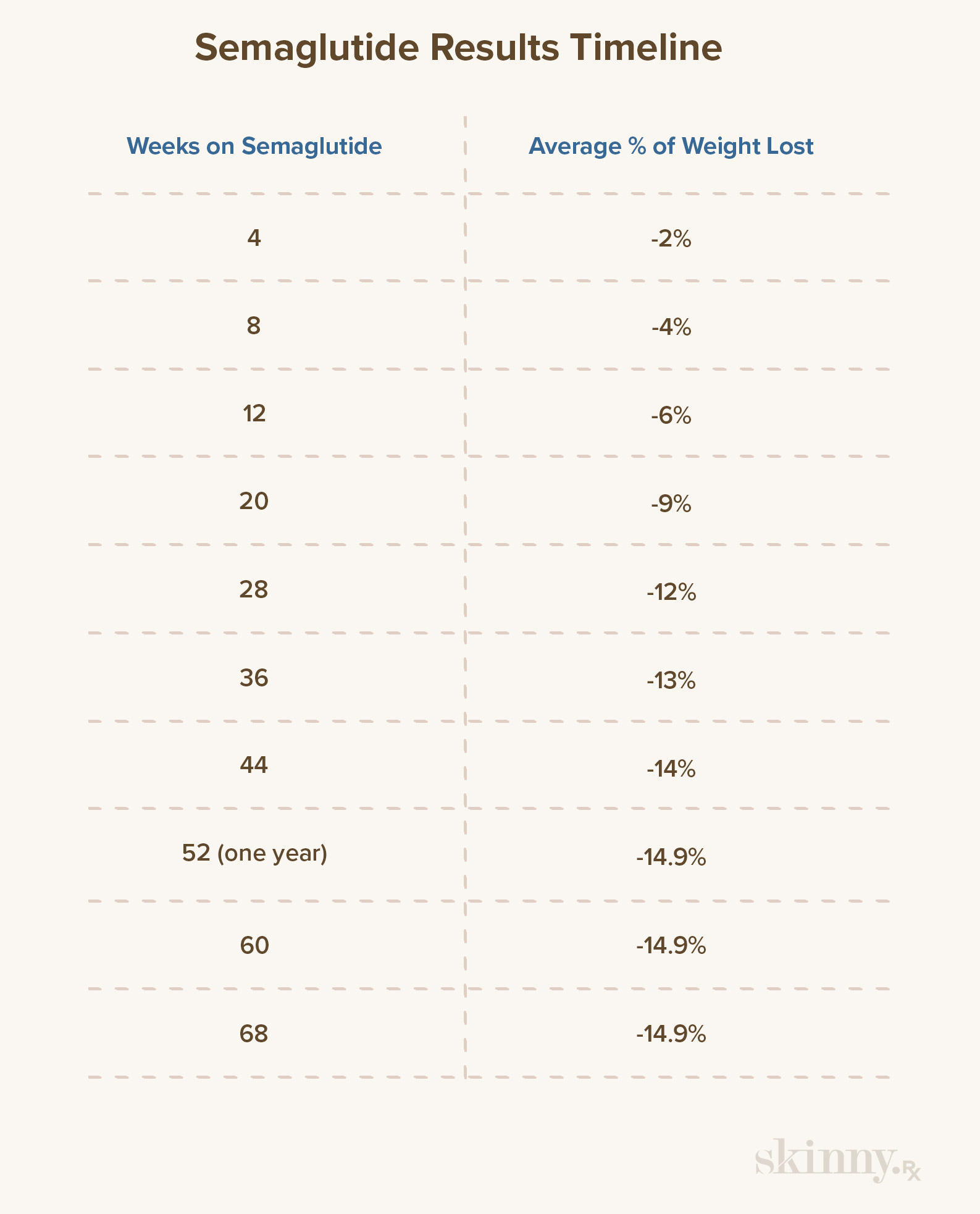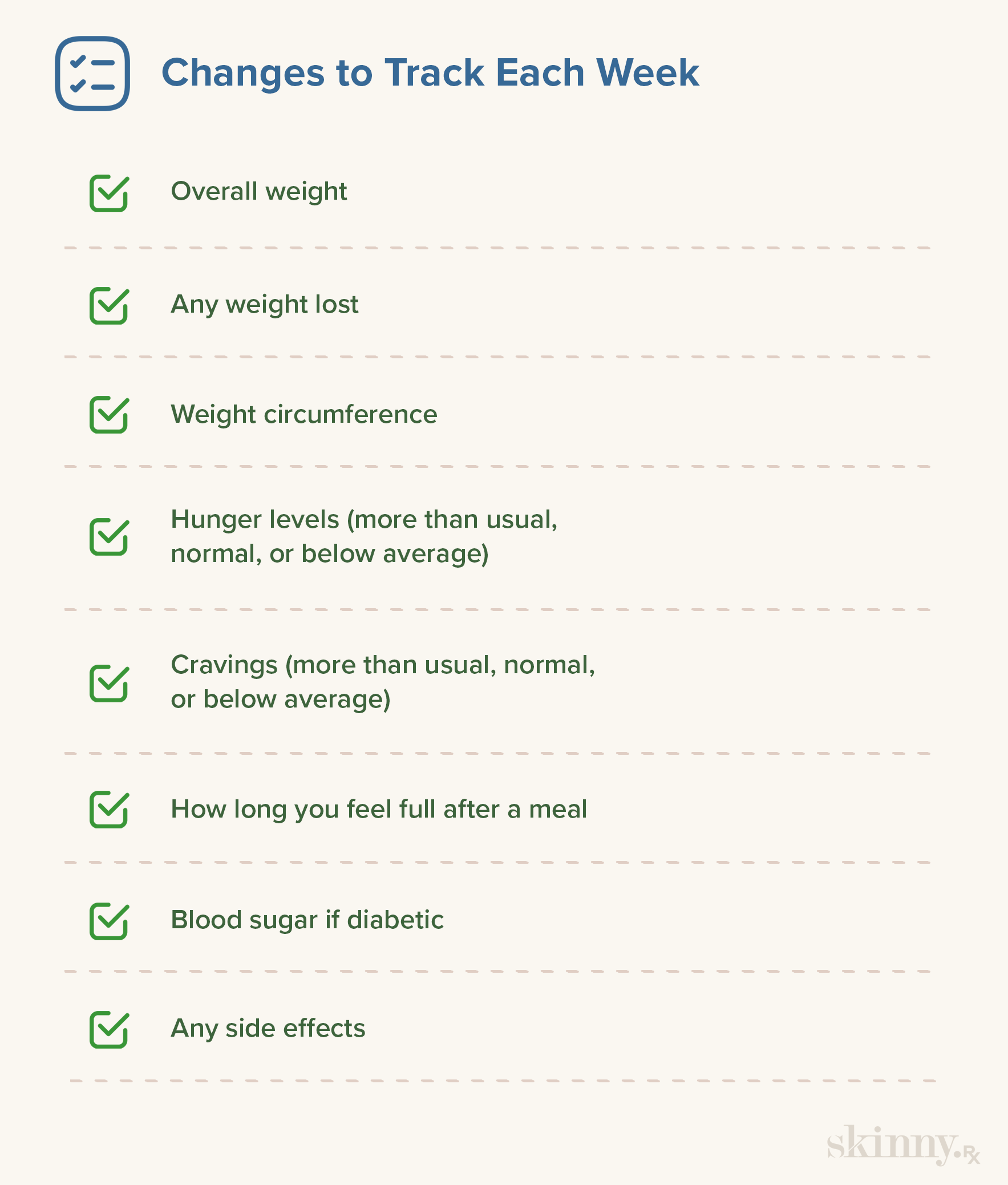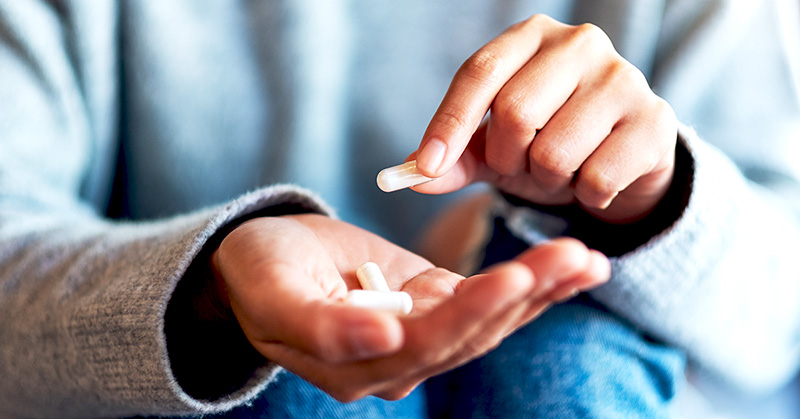
Key Takeaways
- Hunger often decreases within the first week, while weight loss and blood sugar improvements typically begin after 1–3 months and continue steadily over time.
- Wegovy, Ozempic, and Rybelsus vary in purpose and outcomes, with Wegovy leading in average weight loss and Ozempic in blood sugar reduction.
- Diet, exercise, dosage, and genetics all influence how well and how quickly semaglutide works, making individual results highly variable.
- Most weight loss begins after reaching higher doses, which takes about 16 weeks, as semaglutide is gradually increased to reduce side effects.
- Tracking weekly changes in hunger, cravings, and blood sugar can help assess progress, especially since results take time and vary by person.
For many, semaglutide is a life-changing medication. It can help with weight loss, blood sugar control, and appetite suppression, but that doesn’t mean these effects happen overnight. It’s much more realistic to expect the first weight loss and blood sugar changes within one to three months, and appetite suppression and reduced hunger cues within the first week.
Even so, semaglutide isn't a one-size-fits-all medication, meaning results vary. An individual’s lifestyle, diet, genetics, and how well they respond to the medication also play a role.
Here’s a detailed look at how long semaglutide takes to work, how to manage expectations, and tips to speed up progress.
How Semaglutide Works
Before diving into when to expect results from semaglutide, let’s take a step back: how does semaglutide work? Semaglutide is a receptor agonist, a compound which bonds to cell receptors already in the human body, triggering naturally occurring responses. In the case of semaglutide, the drug mimics GLP-1, a hormone that triggers cell receptors in the digestive system and brain.
Once activated, either by naturally occurring GLP-1 or semaglutide, these receptors, when triggered, do several things:
- Lower blood glucose levels: Semaglutide mimics GLP-1's role in regulating blood glucose, effectively lowering blood sugar after a meal.
- Reduce appetite: Semaglutide alleviates some hunger cues and food cravings in the brain.
- Feel full longer: Semaglutide also slows gastric emptying, meaning someone feels full for longer.
Together, these actions mean semaglutide may promote weight loss or help individuals with type 2 diabetes manage their blood sugar.
While all types of semaglutide technically help with both, the three FDA-approved options are intended for different purposes. Ozempic and Rybelsus are FDA-approved to help control blood sugar for individuals with type 2 diabetes.
Wegovy is FDA-approved for weight loss for those with a body mass index (BMI) ≥30 or ≥27 with one or more weight-related comorbidities, such as heart disease or untreated high blood pressure.
Typical Timeline for Results
So, how long does semaglutide take to work? Whether you’re using semaglutide for weight loss or blood sugar control, you can expect to see the first changes within three months, though improvements persist for over a year.
Weight Loss: When to Expect First Changes
Most people lose some weight during the first three months of taking semaglutide, with some individuals experiencing initial changes as early as four weeks. But an individual doesn’t lose all expected weight at the four-week or three-month mark. Instead, they lose weight gradually for months or even years.
In one clinical trial, 1,961 participants experienced an average weight loss of 14.9% after taking 2.4mg of Wegovy for 68 weeks:

Other studies demonstrate varying amounts lost, usually over six months to 68 weeks. Average weight loss in a 2022 study, for example, was 5.9% at the three month mark and 10.9% at six months. In another study, 407 participants on a 2.4mg semaglutide dose lost 16% of their body weight on average over 68 weeks.
Blood Sugar Improvements for Diabetes
Semaglutide improves blood sugar levels in as little as three months, though improvement continues beyond the three month mark. A Hemoglobin A1C (HbA1C) test captures average blood sugar levels in the last two to three months and is used to gauge how well semaglutide manages blood sugar levels.
In a study with 43 patients, the average baseline HbA1C level was 6.72 ± 0.62%. That average lowered to 6.45 ± 0.51% at the three month mark and 6.22 ± 0.54% after six months. Considering a HbA1C level of 7 indicates diabetes, users moved 0.5 away from the diabetic blood sugar level in six months, a signficant improvement.
Another study analyzed individuals with prediabetes who took semaglutide in three different clinical trials. 84.1% of participants in the first study, 89.5% of participants in the second, and 88.9% of participants in the third were within normal blood sugar ranges after taking semaglutide for 68 weeks.
Factors That Affect How Quickly It Works
As the above studies demonstrate, semaglutide results vary quite a bit due to factors like medication type, dose, diet, lifestyle, and genetics.
Medication Type
The type of semaglutide impacts how much weight loss and blood sugar control someone can expect:
Semaglutide Dose
All brands of semaglutide follow a titration schedule, which basically means a healthcare provider will slowly increase the dosage over time. Dosage impacts the effectiveness of semaglutide, with most clinical studies on weight loss finding that 2.4 mg of Wegovy results in the most weight loss.
1 mg or 2 mg of Ozempic is often most effective for blood sugar control, and 7 mg or 14 mg offers the most impact for Rybelsus.
That doesn’t mean you should start with 2.4 mg of Wegovy, 2mg of Ozempic, or 14 mg of Rybelsus. Those doses may lead to serious gastrointestinal reactions, like nausea, stomach pain, diarrhea, and gastritis (inflammation in the stomach lining), if you don’t increase gradually to higher doses.
Instead, follow the dosing guidelines set by the FDA, only increasing the dose when minimal to no side effects are present and under the supervision of a healthcare provider:
Diet and Exercise
No matter what type of semaglutide someone takes, it works better when taken alongside a healthy diet and regular exercise. In the clinical study above with the most average weight loss (16%), all participants followed a low calorie diet and attended 30 behavioral counseling visits within 68 weeks. Taking semaglutide without diet and lifestyle changes may negatively impact the drug’s effectiveness.
Individual Variability
An individual’s metabolism, baseline weight, and genetics also influence how fast the medication works or if it works at all. Unlike diet or dosage, this isn’t entirely within someone’s control, though it’s important to expect some variability, treating any results from clinical studies as guidelines rather than certain outcomes.
How to Know If Semaglutide Is Working
Key signs that semaglutide is working include reduced cravings, feeling full longer, lower blood sugar readings if diabetic, and, of course, weight loss. These often occur within a week of starting semaglutide, though noticeable changes in weight or blood sugar take longer.
Since it can take up to three months for noticeable weight loss, many people find it motivating to track smaller changes each week:
- Overall weight
- Any weight lost
- Waist circumference
- Hunger levels (more than usual, normal, or below average)
- Cravings (more than usual, normal, or below average)
- How long they feel full after a meal
- Blood sugar if diabetic
- Any side effects
Tracked metrics can also be shared with a healthcare provider who can objectively assess progress and monitor treatment if necessary.

Tips to Maximize Results
While results vary, there are ways to maximize weight loss and blood sugar control while taking semaglutide:
- Adjust diet: A very low-calorie diet enables greater weight loss for those on semaglutide. A low-calorie diet means eating less calories than usual, though a healthy caloric amount depends on an individual’s age, weight, and gender and should be determined by a healthcare professional.
- Prioritize fiber and protein: While a low-calorie diet is recommended, that doesn’t mean someone should skimp on fiber, which can help reduce gastrointestinal side effects, and protein, which can help preserve muscle.
- Strength training: On semaglutide, there is a risk of losing muscle, not just fat. Muscles help move the body and provide necessary strength for internal processes, like breathing and blood circulation. To avoid muscle loss, combine semaglutide with two strength training sessions a week (minimum).
- Consider therapy: Many find the combination of behavioral therapy and semaglutide results in sustainable weight loss and healthier habits.
- Manage expectations: Waiting for weight loss or improved blood sugar control can be stress-inducing. By expecting gradual results, not overnight change, individuals can better navigate the emotional side of a semaglutide weight loss journey.
When to Consider Alternatives
If the medication isn’t working, consult a healthcare provider. That doesn’t mean you should make an appointment if you don’t see a change within the first week. Instead, give semaglutide three months to work before considering alternatives.
That said, contact a healthcare provider at any time, even before the three-month mark, if you are experiencing intolerable side effects like abdominal pain, chronic diarrhea, constipation, or nausea.
When side effects are intolerable or expected changes don’t occur, there are other options, such as:
- Weight loss surgery
- Other weight loss medications like liraglutide or tirzepatide
- Non-pharmaceutical interventions, such as behavioral therapy or structured exercise and nutrition programs
Final Thoughts
Whether prescribed semaglutide for blood sugar control or weight management, most people see the first changes within one to three months. Those results often continue to improve for weeks, months, or even years.
While we have baselines on how much weight people lose on semaglutide or by how much blood sugar control improves, there are no guaranteed results.
Semaglutide isn’t a “one-size-fits-all” treatment. Someone’s diet, exercise routine, lifestyle, genetics, and how their body reacts to semaglutide all impact the drug’s effects.


 Medically Reviewed
Medically Reviewed



